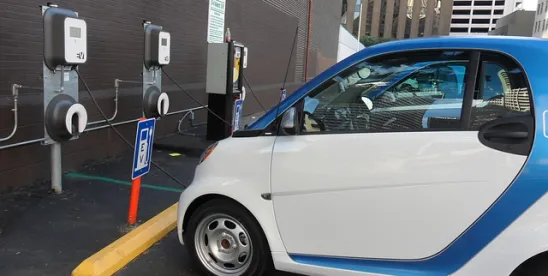Key Takeaways
-
What Happened: The Biden Administration took a significant step toward reducing greenhouse gas (GHG) emissions from mobile sources by issuing a non-binding “Executive Order on Strengthening American Leadership in Clean Cars and Trucks” and proposing a rule to tighten GHG standards for certain passenger cars and light-duty vehicles.
-
What Comes Next: Stakeholders have until September 27, 2021, to submit comments on EPA’s proposed rule. Additional GHG and fuel economy rulemakings are likely to follow.
The Biden Administration recently took significant steps to realize its goal of reducing greenhouse gas emissions from mobile sources, as forecasted in one of President Biden’s first Executive Orders, “Protecting Public Health and the Environment and Restoring Science to Tackle the Climate Crisis.” According to the Environmental Protection Agency (EPA), the transportation sector constitutes 29 percent of all domestic GHG emissions. Most of those emissions are from passenger cars and trucks.
In early August, President Biden issued an Executive Order aimed at promoting the sale of zero-emission vehicles and calling on EPA and the Department of Transportation (DOT) to consider setting new emissions and fuel efficiency standards across the automotive sector. EPA also proposed its first Biden-era emissions standards for passenger cars and light-duty trucks. These actions intend to build on and integrate President Biden’s Build Back Better Agenda and the Bipartisan Infrastructure Deal.
President Biden Signs Electric Vehicle Executive Order
On August 5, 2021, President Biden signed the Executive Order on Strengthening American Leadership in Clean Cars and Trucks, which sets an ambitious goal for 2030 that 50 percent of all new U.S. sales of passenger cars and light-duty trucks will be zero-emission vehicles.
The Executive Order itself does not contain any binding requirements, but it calls on EPA and the DOT to consider promulgating new emissions and fuel economy standards. Specifically, the Executive Order directs EPA to consider (i) issuing a proposed rule by January 2022 addressing oxides of nitrogen (NOx) standards for heavy-duty engines and vehicles beginning with MY 2027 and extending through at least MY 2030 and (ii) finalizing the rulemaking by the end of 2022. Without setting a specific date, the Executive Order also directs EPA to consider issuing a rule regarding GHG emissions standards for heavy-duty engines and vehicles beginning with MY 2027 and extending through at least MY 2029.
The Executive Order also directs EPA and DOT to issue final rules by July 2024 addressing:
-
Multi-pollutant emissions standards, including greenhouse gas (GHG) emissions, for light- and medium-duty vehicles beginning with model year (MY) 2027 and extending through at least MY 2030;
-
Fuel economy standards for passenger cars and light-duty trucks beginning with MY 2027 and extending through at least MY 2030;
-
Fuel efficiency standards for heavy-duty pickup trucks and vans beginning with MY 2028 and extending through at least MY 2030;
-
GHG emissions standards for heavy-duty engines and vehicles to begin as soon as MY 2030; and
-
Fuel efficiency standards for medium- and heavy-duty engines and vehicles to begin as soon as MY 2030.
In a shift from the previous administration, President Biden also directs EPA to coordinate with California as well as the other Section 177 states that have adopted California’s vehicle standards.
The White House released “Statements on the Biden Administration’s Steps to Strengthen American Leadership on Clean Cars and Trucks” from leading automakers, as well as the United Autoworkers and the governor of California.
The Biden EPA Proposes Its First GHG Standards
The Executive Order coincides with the Biden EPA’s first proposed GHG standards for mobile sources under the Clean Air Act (CAA). On July 29, 2021, EPA Administrator Michael Regan signed a proposal to tighten GHG standards for certain passenger cars and light-duty vehicles. The agency frames its proposal as “put[ting] EPA’s clean cars program back on track to achieve significant GHG emissions reductions over the long term.”
EPA published its proposal in the Federal Register on August 10, with a 48-day comment period. The comment period closes on September 27, 2021, which will be exactly two years from when the Trump Administration finalized Part One of the Safer Affordable Fuel-Efficient Vehicle Rule (“the SAFE Rule”). The SAFE Rule has two parts:
-
Part One of the SAFE Rule withdrew a CAA preemption waiver EPA issued to the California Air Regulatory Board (CARB).[1] On February 8, 2021, at the Biden Administration’s request, the D.C. Circuit stayed litigation over the SAFE Rule while EPA reevaluated Part One. EPA then opened a comment period on whether to rescind Part One, which would reinstate CARB’s waiver.[2] EPA is currently evaluating those comments.
-
Part Two of the SAFE Rule finalized new federal standards for corporate average fuel economy and GHG emissions for passenger vehicles and light-duty trucks sold in model years 2021–2026. These federal standards were less stringent than earlier, Obama-era standards. Whereas the Obama-era rules would have tightened approximately 5% year-over-year, the Trump-era rules loosened that trajectory to about 1.5% year-over-year.
The new EPA proposal concludes that Part Two of the SAFE Rule “significantly weakened” the 2012 standards, and that more stringent standards are appropriate under the CAA “in light of the significant contribution of light-duty vehicles to transportation sector GHG emissions.”[3] Beginning in MY 2023, the proposed rule would significantly increase federal standards compared to the SAFE Rule—requiring an approximately 10% increase compared to the prior MY 2022. This increase would largely bring emissions standards back to where they would have been under the Obama Administration. Stringency would then increase approximately 5% per year in MY 2024 through 2026, although EPA is taking comment on even tighter standards for MY 2026.
EPA justifies these proposed changes to the SAFE Rule standards on “technical investments” made by industry in recent years, as well as compliance flexibilities built into the proposed rule. The agency notes, for example, that the number of EV and plug-in hybrid electric vehicles (PHEV) models has more than doubled since MY 2015; that many automakers have announced their intentions to shift away from internal-combustion technologies; and that numerous states and foreign countries have taken action to incentivize or require shifts to electric vehicles.
As with prior GHG standards, compliance would be primarily determined via the credit-based GHG emissions averaging, banking, and trading (ABT) program. The tighter standards, coupled with inherent flexibilities in the credit-based program, may lead to the further adoption of electric vehicles and other low- or zero-emission vehicles. However, EPA’s proposal includes several new or reinstated compliance options that are likely to prospectively encourage such sales:
-
The proposal would reinstate credit “incentive multipliers” for EVs, PHEVs, and fuel cell vehicles that would over-weigh those vehicles in compliance calculations in order to incentivize their production.[4] The credit multipliers would range from 1.45x to 2.0x credit, depending on the model year and technology. However, EPA newly proposes to cap the amount of credits a manufacturer can functionally generate via incentive multipliers, and also to sunset these multipliers after MY 2025. EPA also proposes to end multiplier incentives for natural gas vehicles (NGVs) after MY 2022.[5]
-
For full-size pickup trucks, the proposal would reinstate a per-vehicle credit for pickups that use mild or strong hybrid technologies. Pickup truck manufacturers could alternatively generate performance-based credits for full-size pickups that exceed CO2 performance by at least 15% or 20%, regardless of the technology used.
-
The proposal would increase the availability of “off-cycle” technology credits that reduce GHG emissions. These are technologies that have an impact on vehicle fuel efficiency and GHG emissions, but that are not measured during the ordinary city and highway test cycles. Examples include technologies like high-efficiency headlamps, or vehicle paints and ventilation that reduce the need for air conditioning.[6] EPA proposes to increase the quantity of credits obtainable from off-cycle technologies from the current 10 grams/mile up to 15 grams/mile
Looking to the Future
The Biden Administration anticipates that EPA’s proposal and the various rulemakings addressed in the Executive Order will save about 200 billion gallons of gasoline, reduce around two billion metric tons of carbon emissions, and deliver around $140 billion in net benefits over the life of the program. Stakeholders will want to follow closely the EPA and DOT rulemakings that are aimed to achieve these ambitious goals.
[1] 84 Fed. Reg. 51,310 (Sept. 27, 2019). Part One of the SAFE Rule also included a determination by the National Highway Traffic Safety Administration (NHTSA) that states are preempted by the Energy Policy and Conservation Act (EPCA) from regulating tailpipe GHG emissions or imposing zero-emission vehicle (ZEV) mandates.
[2] 86 Fed. Reg. 22,421 (Apr. 28, 2021).
[3] 86 Fed. Reg. 43,726 (Aug. 10, 2021).
[4] Part Two of the SAFE Rule had eliminated the multipliers for these vehicles while retaining the multiplier for natural gas vehicles (NGVs).
[5] EPA justifies ending the NGV multipliers because NGVs “are not a near-zero emissions technology” and the agency believes that NGV incentives “are no longer necessary or appropriate.” EPA says that it does not expect that ending NGV incentives would affect the feasibility of the emission standards because no manufacturers presently offer NGVs in the light-duty market. 86 Fed. Reg. at 43,760.
[6] See 40 C.F.R. § 86.1869-12.





 />i
/>i
